10 Most Sustainable Recycled Fabrics Clothing Brands: The Conscious Consumer’s Guide
Impactful Ninja is reader-supported. When you buy through links on our site, we may earn an affiliate commission.
Learn more
Learn more
.
Hey fellow impactful ninja ? You may have noticed that Impactful Ninja is all about providing helpful information to make a positive impact on the world and society. And that we love to link back to where we found all the information for each of our posts. Most of these links are informational-based for you to check out their primary sources with one click. But some of these links are so-called "affiliate links" to products that we recommend. First and foremost, because we believe that they add value to you. For example, when we wrote a post about the environmental impact of long showers, we came across an EPA recommendation to use WaterSense showerheads. So we linked to where you can find them. Or, for many of our posts, we also link to our favorite books on that topic so that you can get a much more holistic overview than one single blog post could provide. And when there is an affiliate program for these products, we sign up for it. For example, as Amazon Associates, we earn from qualifying purchases. First, and most importantly, we still only recommend products that we believe add value for you. When you buy something through one of our affiliate links, we may earn a small commission - but at no additional costs to you. And when you buy something through a link that is not an affiliate link, we won’t receive any commission but we’ll still be happy to have helped you. When we find products that we believe add value to you and the seller has an affiliate program, we sign up for it. When you buy something through one of our affiliate links, we may earn a small commission (at no extra costs to you). And at this point in time, all money is reinvested in sharing the most helpful content with you. This includes all operating costs for running this site and the content creation itself. You may have noticed by the way Impactful Ninja is operated that money is not the driving factor behind it. It is a passion project of mine and I love to share helpful information with you to make a positive impact on the world and society. However, it's a project in that I invest a lot of time and also quite some money. Eventually, my dream is to one day turn this passion project into my full-time job and provide even more helpful information. But that's still a long time to go. Stay impactful,Affiliate Disclosure
Why do we add these product links?
What do these affiliate links mean for you?
What do these affiliate links mean for us?
What does this mean for me personally?
![]()
Amid growing concerns about the textile industry’s environmental impact, there is pressure to find greener clothes for your wardrobe. Recycled fabrics are becoming quite the preferred textile materials as they don’t require virgin natural resources and help to reduce waste. But are all recycled fabrics green or somewhat greenwashed? So, we had to ask: Which are the most sustainable recycled fabrics clothing brands?
The most sustainable recycled fabrics clothing brands are Patagonia, Ecoalf, and Girlfriend Collective, which use low-impact materials, employ full traceability, and strive for circularity. In addition, MUD Jeans and Arvin Goods increase recycled content and adhere to supply chain transparency.
Whether you are searching for a winter jacket, a pair of yoga pants, or some comfortable underwear to add to your wardrobe without negatively impacting the soil, the water, the animals, and other people, there is a brand for you. So, let’s keep reading to learn more about the most sustainable recycled fabrics clothing brands and how they ensure sustainable, ethical practices.
Here’s How Sustainable Recycled Fabrics Generally Are
Recycled fabrics are made with fibers reclaimed from waste, lessening the pressure on extracting virgin natural resources and diverting waste away from landfills back into circulation. Consequently, recycled fabrics are often considered sustainable. For example, the Common Objective’s Made-By Environmental Benchmark for Fibres ranked several types of recycled fabrics (recycled cotton, recycled wool, mechanically recycled polyester, and mechanically recycled nylon) as class A—the most sustainable category of fibers.
“Sustainable: The ability to be maintained at a certain rate or level | Avoidance of the depletion of natural resources in order to maintain an ecological balance”
Oxford Dictionary
To understand the sustainability of recycled fabrics, we’ve assessed the life-cycle and each stage’s sustainability. This life-cycle assessment (LCA) is a method to evaluate the environmental impacts of products and materials. Here’s a quick summary of our LCA of recycled fabrics!
What makes it so sustainable: Manufacturing recycled fabrics with discarded materials reduces waste, lessens pressure on natural resources, and demands relatively less energy.
Additionally: Recycled fabrics made with 100% natural fibers, such as cotton or wool, are biodegradable at the end of their life.
Related: Are you interested in the whole story of recycled fabrics? Then check out our full article: “How Sustainable Are Recycled Fabrics? A Life-Cycle Analysis”.
Here’s How We Selected the Most Sustainable Recycled Fabrics Clothing Brands
The brands on this list were chosen based on their commitment and actions to promote sustainable practices while reducing the environmental impacts of the textile industry.
They are transparent about their materials, processes, and workforce management within their supply chain.
Some brands focus their efforts on reducing waste and optimizing natural resources while others strive to reduce the carbon footprint of their clothes.
All of these brands share the commitment to reshape the textile industry toward a more sustainable and Earth-friendly sector.
These Are the 10 Most Sustainable Recycled Fabrics Clothing Brands
Most Sustainable Recycled Fabrics Clothing Brands
Overall, these recycled fabrics clothing brands are sustainable. Yet, they take various approaches to reduce environmental impacts and uphold ethical standards. Let’s dive into each brand and find out more.
Patagonia: Everyday Wear for Those Who Care

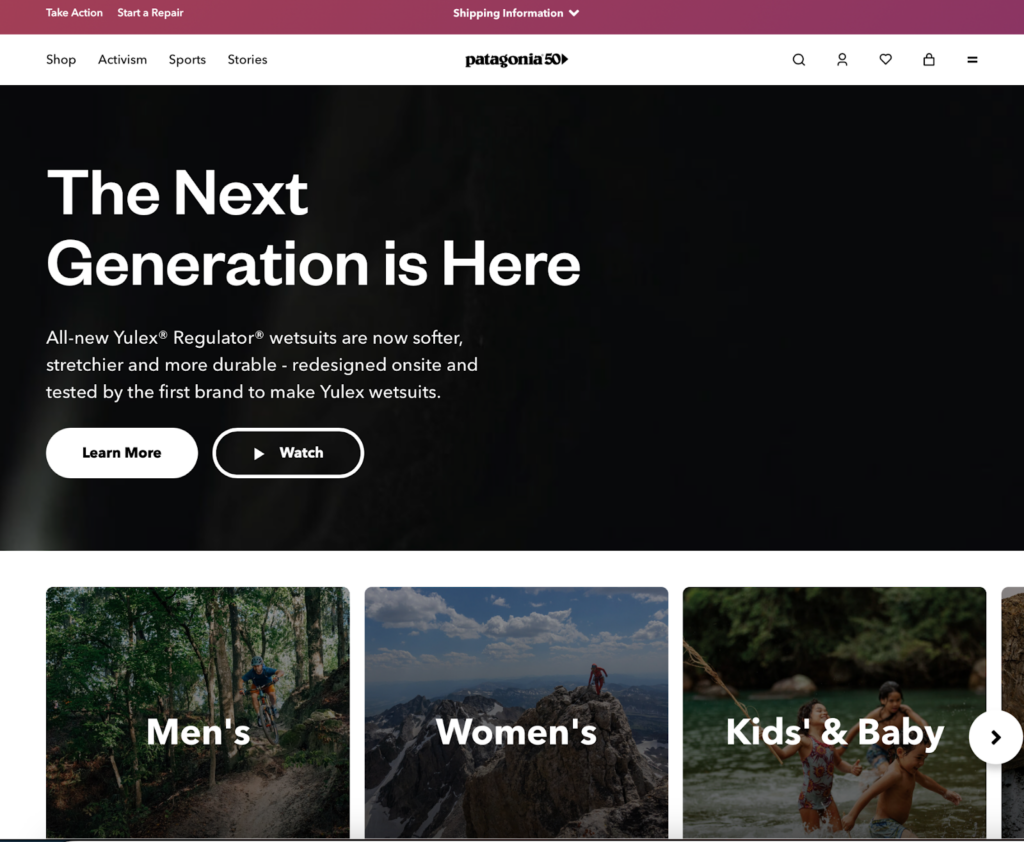
“Together, we can prioritize purpose over profit and protect this wondrous planet, our only home.”
Patagonia
🌎
How do they ensure their sustainability?
Patagonia puts sustainability at the center of their operation. They work to reduce, rather than simply offset, carbon emissions where it matters the most: in the supply chain and material manufacturing. They reduce their carbon footprint by removing high-impact virgin fossil-based fibers from their collections, using “Environmental Profit and Loss” to guide their production decision, and helping their suppliers to cut emissions. In particular, Patagonia prioritizes using recycled synthetic fabrics (recycled polyester, recycled nylon, recycled spandex). On top of that, they also add the recycled alternatives of some resource-intensive natural fabrics, including recycled sheep wool, recycled cashmere, recycled down, and recycled cotton. Furthermore, Patagonia’s Worn Wear program encourages customers to repair and recycle their products, extending the textile lifecycle and reducing waste. Lastly, Patagonia is certified as a B Corporation and a Bluesign® brand.
🌐
How do they ensure their ethics?
Patagonia commits to fair trade practices. Through the partnership with Fair Trade USA, they currently produce 86% of their clothes in 20 Fair Trade Certified™ factories. Patagonia pays a premium for every item produced in such factories, accumulating in a fund for workers to use in their chosen community projects, whether in healthcare or parent support or to withdraw as a cash bonus. Additionally, they have various social responsibility programs to prevent harm and create positive impacts on the lives of apparel workers in their supply chain. These include the Fair Labor Association, the Living Wage Program, the Migrant Workers Program, and the Responsible Purchasing Practices. Patagonia is also fully transparent about the locations of their facilities and suppliers.
🤝
Are they part of any giving-back programs?
Since 1985, Patagonia has pledged 1% of sales annually to environmental causes. They have awarded over $89 million in cash and in-kind donations to domestic and international grassroots environmental groups, making a difference in their local communities. In 2022, the founder of Patagonia gave away his family’s ownership of the company to the newly created Patagonia Purpose Trust and the not-for-profit organization Holdfast Collective, ensuring that all future profits from the company are used to fight the climate and extinction crisis.
🛍️
What is their product range?
- Best for: kidswear, menswear, womenswear
- Product range: shirts, pants, jackets, blazers, hoodies, sweatshirts, T-shirts, shorts, plus-size
- Price range: $$$
- Size range: XXS–XXXL
Ecoalf: Committing to Recycling Waste and Cleaning the Environment


“I believe the time when fashion was just about looking good is over. More than ever it has to be about doing what is right and feeling good about it.”
Javier Goyeneche, founder of Ecoalf
🌎
How do they ensure their sustainability?
Ecoalf’s commitment to sustainability is evident in their innovative recycling practices. They minimize the use of natural resources by using recycled fabrics. Ecoalf collects and transforms discarded materials such as plastic bottles, discarded fishing nets, and post-industrial cotton into high-quality fashion items. In 2023, they launched their first 100% recycled cotton collection that can be recycled again to achieve circularity. In 2021, 74% of the materials used by Ecoalf were recovered from waste, saving 1,377 tons of CO₂. In combination with recycled fabrics, including mechanically recycled cotton, recycled wool, recycled polyester, and recycled nylon, Ecoalf uses a small percentage of low-impact natural fabrics, such as linen and kapok. Ecoalf is also Bluesign® and B Corporation certified.
🌐
How do they ensure their ethics?
Ecoalf ensures their ethics by protecting their workers and the environment. In particular, they ensure there are safe and fair working conditions in their supply chain by mandating a Code of Conduct, an Equality Scheme, a Crime Prevention Handbook, a Disciplinary System, and a Bullying at Work Protocol. Additionally, they run many campaigns to raise awareness of the state of our oceans and earth-damaging consumerism habits.
🤝
Are they part of any giving-back programs?
Ecoalf actively participates in giving-back programs. The Ecoalf Foundation was founded to clean the oceans of marine waste with the help of the fishing industry while giving a second life to plastic waste through recycling and closing the loop. They achieve that with the “Upcycling the Oceans” projects. In 2021, Ecoalf donated 10% of all Because There’s No Planet B sales to the Ecoalf Foundation to expand the “Upcycling the Oceans” project beyond the Spanish border and into countries like Thailand, Greece, and France. The foundation also partners with Biotherm to set up the framework of “Limpia ríos, salva océanos”, a project supported by corporate volunteer days to collect waste and restore the environment. Additionally, Ecoalf’s employees volunteer in various environmental incentives.
🛍️
What is their product range?
- Best for: womenswear, menswear, kidswear
- Product range: shirts, pants, jackets, blazers, hoodies, sweatshirts, tops, blouses, knitwear, T-shirts, sneakers, accessories
- Price range: $$
- Size range: XS–XL
Girlfriend Collective: Essential and Timeless Activewear Made Out of Recycled Materials

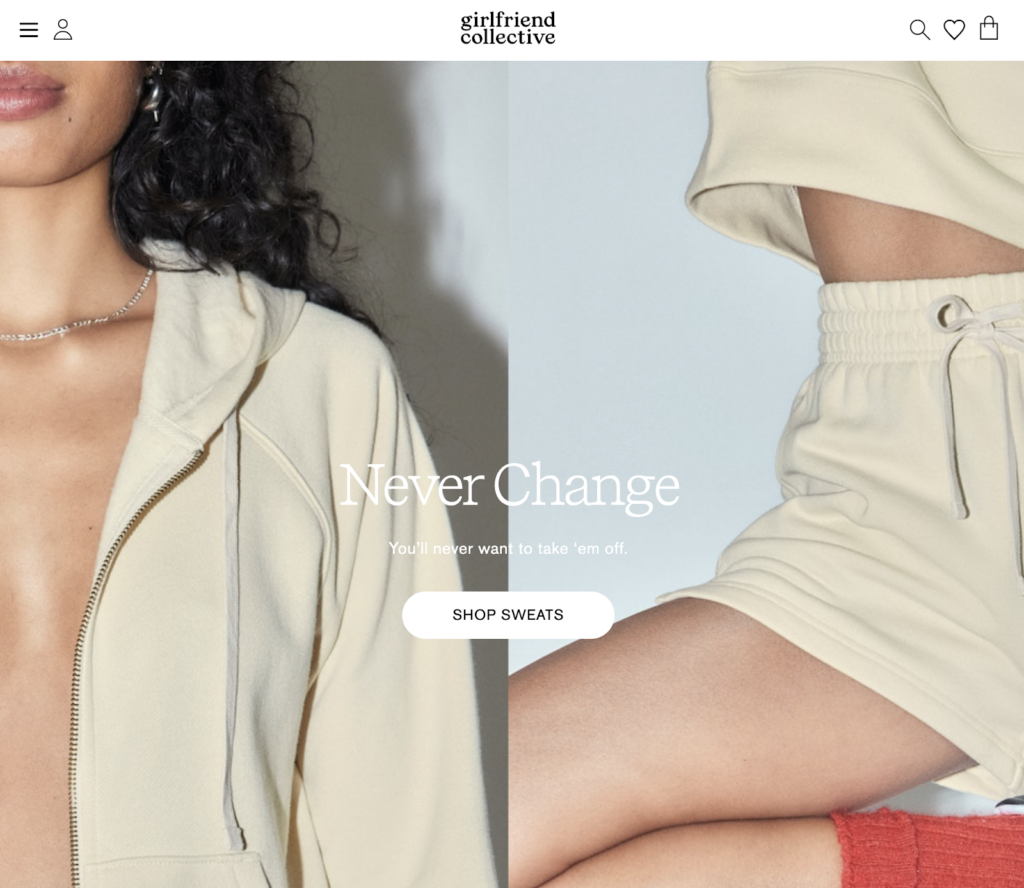
“We make everything locally in small batches to make sure we don’t have a negative impact on the environment.”
Girlfriend Collective
🌎
How do they ensure their sustainability?
Girlfriend Collective‘s sustainability efforts start with using recycled and recyclable textile and packing materials. Their clothes are made from recycled materials such as post-consumer water bottles, fishing nets retrieved from the seas, fabric scraps, and other waste. On top of that, their packaging is 100% recycled and recyclable. After their clothes are dyed, all the wastewater is sent to a treatment plant 100 feet away. Treated water that meets safety standards is released into the waterway, while mud dye is donated to a pavement facility to be turned into paving stones. Additionally, they help prevent microfiber release with a branded microfiber filter. Their program “Recycle. Reuse. Regirlfriend.” collects old Girlfriend Collective compressive leggings and upcycles them into new pieces that can be worn again and again, reducing waste while moving toward a more circular fashion model. Lastly, Girlfriend Collective partners with EcoCart to provide a carbon-neutral option for all orders placed on their site to offset the carbon footprint of their products.
🌐
How do they ensure their ethics?
Girlfriend Collective’s facilities are fully certified by Social Accountability International – SA8000. An SA8000 certification guarantees safe working conditions,the right to unionize, and no forced child labor. They also ensure all workers in their supply chain are paid fair wages and provided with free lunches and guided exercise breaks.
🤝
Are they part of any giving-back programs?
Girlfriend Collective is not known to be part of any giving-back programs.
🛍️
What is their product range?
- Best for: womenswear
- Product range: dresses, hoodies, sweatshirts, activewear, sportswear, maternity wear, tops, blouses, T-shirts, stockings, tights, shorts, lingerie, plus-size
- Price range: $$$
- Size range: XS–XL
MUD Jeans: Quality Jeans Made Ethically With Organic and Recycled Cotton
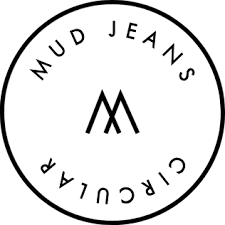
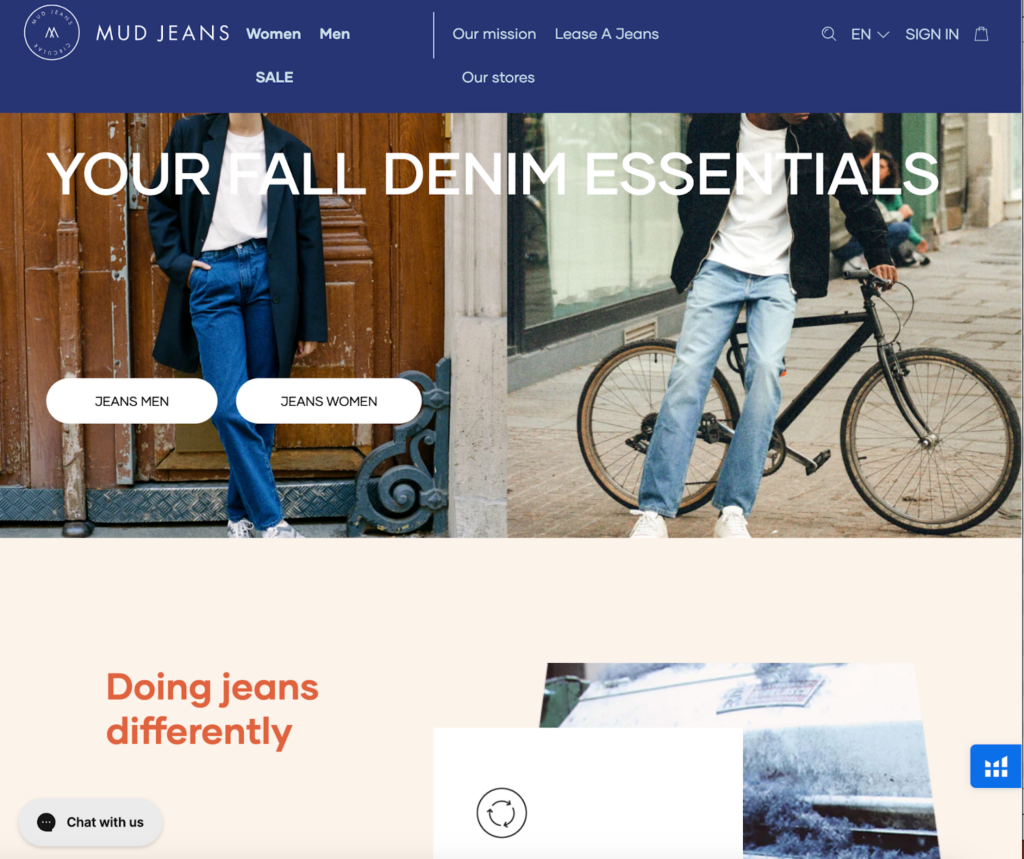
“With our circular philosophy, we want to design our products in a way that they can be reused, recycled and upcycled easily.”
MUD Jeans
🌎
How do they ensure their sustainability?
MUD Jeans prioritizes sustainability by committing circular principles in every step of the life cycle of their products, including design, materials, production techniques, and end-of-life. They recycle fabrics and water across the supply chain. Their factory’s laundry recycles 95% of their water through reverse osmosis. Most of their jeans are made from a mix of low-impact certified organic cotton, up to 40% post-consumer recycled cotton (recovered from jeans they take back), and a maximum of 2% recycled elastane. MUD Jeans also replaced PP spray with Cradle2Cradle indigo dye to make their product toxin-free. They are transparent about the environmental impacts of their clothes by sharing their annual life cycle analysis, which includes the methods they used to lower their water and carbon footprint. Furthermore, their “Lease a Jeans” program encourages consumers to own less and recycle more.
🌐
How do they ensure their ethics?
MUD Jeans is fully transparent about their manufacturing processes, maintaining fair conditions for workers. They consciously maintain a small supply chain of three recyclers, three fabric producers, and one jeans manufacturer, enabling clear oversight over who makes their jeans, how, and under what conditions. They uphold all their main supply chain partners to their Code of Conduct, which covers the ILO’s Four Fundamental Freedoms principles.
🤝
Are they part of any giving-back programs?
MUD Jeans partners with Justdiggit to regenerate trees and revive deforested areas. For every pair of jeans sent back to them, they donate to Justdiggit to restore one tree. The non-profit organization uses a special pruning technique to regenerate forgotten tree stumps in previously deforested areas in Sub-Saharan Africa, bringing back trees, increasing carbon sequestration, cooling down the site, increasing water retention, and promoting biodiversity.
🛍️
What is their product range?
- Best for: womenswear, menswear
- Product range: jeans, jackets, shirts, shorts, skirts, accessories
- Price range: $$
- Size range: XS–XL
Arvin Goods: Sustainable Apparel Accessories With a Commitment to Transparency

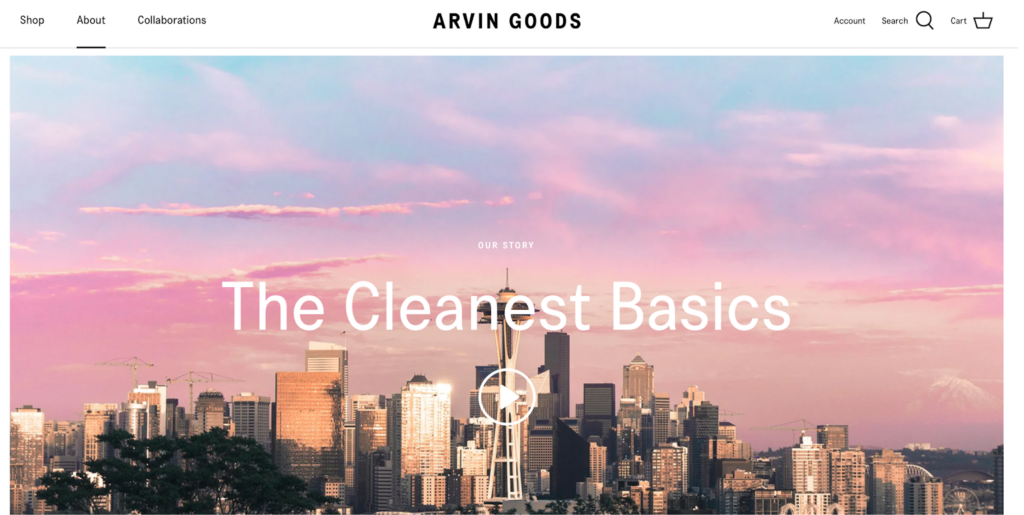
“We foster and lead impact reduction by making low-impact basics that never compromise on performance, comfort, quality — or ethics.”
Arvin Goods
🌎
How do they ensure their sustainability?
Arvin Goods ensures sustainability by focusing on recycling and upcycling materials to close the textile loop. They use recycled cotton, which they recover from textile scraps, to make comfortable and fitting socks. Other recycled fabrics used in Arvin Goods’ products are hemp biofiber (recycled hemp), recycled wool, recycled polyester, and recycled nylon. They are also certified by the Global Recycled Standard (GRS). Their “Take Back Bag” is a convenient solution for recycling and giving new purpose to used clothes. Additionally, their products are dyed according to the Plant Dye Standard, which increases energy efficiency. Arvin Goods produces some of their products in a factory that runs on 50% solar power. Finally, Arvin Goods uses responsible packaging, including a recycled and recyclable card wrap for socks and durable, recycled paper outer packaging from EcoEnclose EcoX Mailers.
🌐
How do they ensure their ethics?
Arvin Goods is transparent about their manufacturing locations and practices. They source their recycled cotton base yarn from a facility in Spain and manufacture the end products in one factory in Portugal and another in Canada. These locations have relatively high standards for labor safety. Arvin Goods is also GOTS and GRS certified, both of which ensure traceability in the supply chain.
🤝
Are they part of any giving-back programs?
Arvin Goods is not known to be part of any giving-back programs.
🛍️
What is their product range?
- Best for: womenswear, menswear
- Product range: socks, T-shirts, sweatshirts, hoodies, accessories
- Price range: $$
- Size range: S–XXL
ASKET: Timeless Clothes Made Under Full Transparency and With Life-Cycle Responsibility
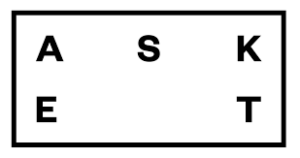

“Our mission is to end overconsumption and restore value to the clothing industry.”
Jakob Dworsky, founder of ASKET
🌎
How do they ensure their sustainability?
ASKET ensures sustainability by reducing waste and using little energy throughout the life-cycle of their garments. They tackle the textile waste problem with their Repair Program which helps keep clothes last longer and their Revival Program which diverts used garments from landfills to be repaired, renewed, resold, or recycled. On top of that, they use various recycled fabrics, including recycled wool, recycled cashmere, and recycled synthetic fabrics. ASKET also runs a Care Program, helping consumers keep their garments fresh longer while using less energy, lowering the environmental impact of the usage stage. In an effort to encourage consumers to buy and waste less, they are fully transparent about the environmental impact of their clothes.
🌐
How do they ensure their ethics?
ASKET maintains ethics through fair labor practices, responsible sourcing, and a commitment to transparency in their supply chain. In 2022, their average traceability score across their entire collection was 96.0%. Regarding animal rights, they follow the Responsible Wool Standard, appropriately addressing sheep’s welfare and the land they graze on.
🤝
Are they part of any giving-back programs?
ASKET is not known to be part of any giving-back programs.
🛍️
What is their product range?
- Best for: high-quality, essential, versatile wardrobe pieces
- Product range: tops, sweaters, pants, chinos, jackets, coats, socks, underwear
- Price range: $$$
- Size range: XS–XXL
Finisterre: Ocean-Inspired Sustainable Outdoor Gear Made Ethically

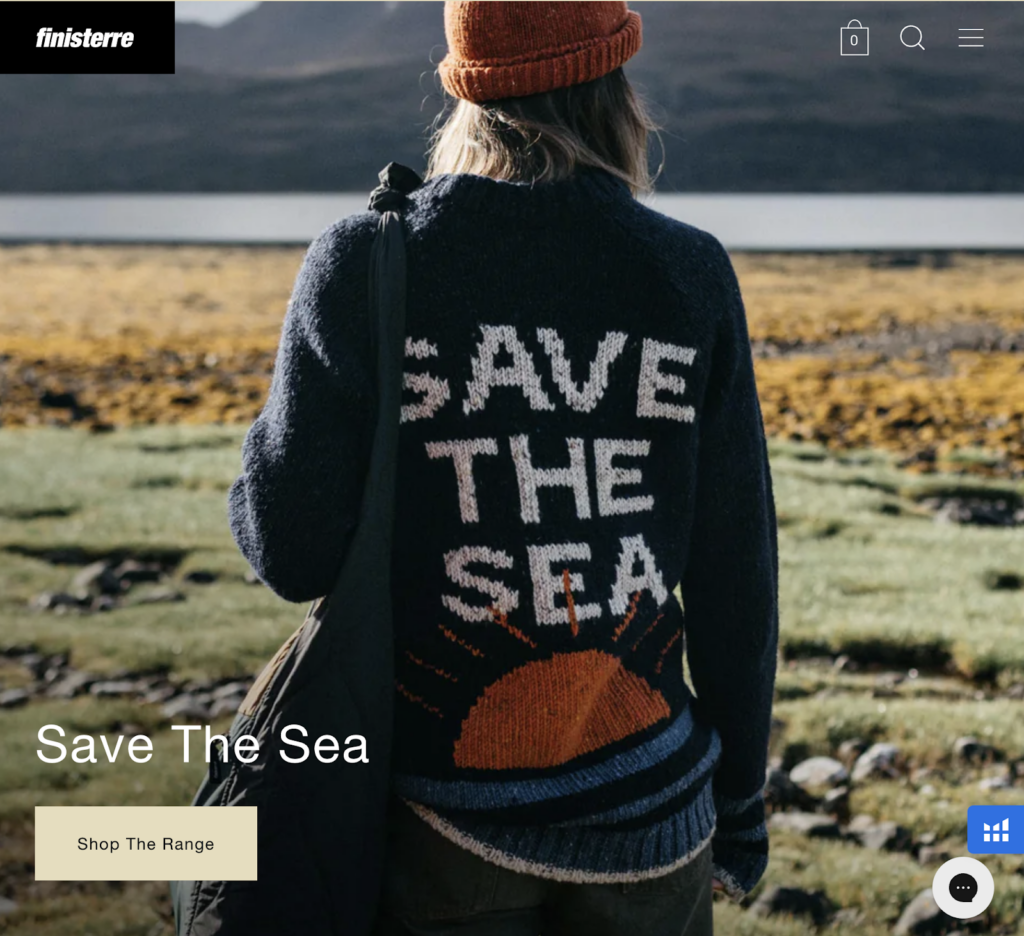
“Yet from our cliff top workshop, we stay true to our original design ethos of functionality and sustainability, remaining committed to product, environment and people.”
Tom Kay, Founder of Finisterre
🌎
How do they ensure their sustainability?
Finisterre places circular sourcing at the center of their sustainability commitment. They use renewable and recyclable textiles and biodegradable natural fibers and finishes. Furthermore, at least 50% of their clothes are made using recycled fabrics. For example, in 2022, 87% of the synthetic polymer fabrics used in Finisterre clothes were from recycled materials, including recycled polyamide recovered from post-consumer and post-industrial waste. They also use low-impact natural fibers, including GOTS-certified organic cotton, hemp, linen, and bamboo. In 2019, they replaced all plastic packaging with water-soluble, ocean-safe, and biodegradable “Leave No Trace” garment bags. Finisterre strives to reduce textile waste by offering repair services and giving in-store credits for gear trade-ins, which are reconditioned for resale. They also implement various incentives to reduce their carbon footprint, including switching more of their stores and offices to renewable energy tariffs and transporting products using less carbon-intensive modes on land and sea. Last but not least, Finisterre is a B Corporation.
🌐
How do they ensure their ethics?
Finisterre is committed to full transparency in their supply chain, holding their partners to the high standards in their Code of Conduct and their Anti-Slavery & Trafficking Policy. Additionally, they partner with Fair Working Conditions (FWC), enabling the mapping of their supply chain, the screening of suppliers, and targeted audits at high-risk locations. Their facilities are also listed on Open Supply Hub. Finisterre’s ethical values also extend to their dedication to saving the sea. For example, they provide a free resource to inspire ocean activism.
🤝
Are they part of any giving-back programs?
Finisterre provides financial support to various giving-back campaigns and programs through the Finisterre Foundation, championing ocean access for all. For example, Finisterre turned 2021’s Black Friday into Blue Friday, where they swapped discounts for donations, raising funds for the Wetsuit Project, which adapts wetsuits for children and adults with various disabilities to access the sea. In 2022, Blue Friday was used again to raise money supporting Level Water to provide specialist swimming lessons for children with disabilities. Other projects include The Seasuit Project, City Kids Surfing, Seasuit Donation, and Art Auctioning for Good.
🛍️
What is their product range?
- Best for: menswear, womenswear
- Product range: shirts, pants, tops, sweaters, dresses, hoodies, shorts, denim, swimwear, jackets, blazers, sweatshirts, T-shirts, base layers, socks
- Price range: $$
- Size range: XS–XXL
Vitamin A: Swimwear and Beachwear Made Sustainably With Recycled Nylon
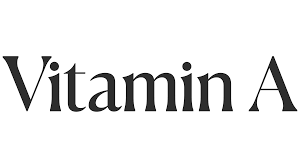

“We focus on the intersection of flawless fit, high quality, continuous innovation, and elegant designs… Every one of our pieces is designed by women, for women.”
Amahlia Stevens, founder of Vitamin A
🌎
How do they ensure their sustainability?
Vitamin A ensures their sustainability by sourcing recycled synthetic materials for their products and manufacturing them locally using low-impact technologies. They use recycled nylon in place of virgin nylon to create fabric blends for their bikinis, swimsuits, and beachwear lines, saving 77% water usage. The brand also incorporates sustainable natural fabrics and high-performing plant-based textiles into their products, including GOTS-certified organic cotton, linen, recycled cotton, and TENCEL™. All materials used by Vitamin A are certified to meet the global OEKO-TEX® STANDARD 100 for safe textiles. On top of that, the majority of their swimwear is crafted locally in Californian vertically integrated facilities (and the rest in the US), reducing the transporting carbon footprint. Regarding production, they use mostly digital printing, which requires less water and creates less fabric waste than traditional wet printing. Other measures used at their headquarters and warehouse to reduce their environmental footprint include all paper products made with 100% recycled post-consumer waste, no disposable plastic water bottles, a heat reclamation system, and working-from-home support to avoid unnecessary travel.
🌐
How do they ensure their ethics?
Vitamin A ensures their ethical and responsible production by keeping production locally in California, which has the strictest environmental laws in the nation. They visit their factories regularly to ensure employees are being treated and paid fairly and that the working conditions are clean and safe.
🤝
Are they part of any giving-back programs?
Vitamin A is a proud member of 1% for the Planet. They give back to organizations that work to protect the oceans. Additionally, they host beach cleanups.
🛍️
What is their product range?
- Best for: womenswear
- Product range: swim tops, swim bottoms, beach tops, beach bottoms, one pieces, dresses, rompers, shirts, pants, overalls, hoodies, shorts, accessories
- Price range: $$
- Size range: XS–XXL
Rapanui: Made-to-Order Clothes Using Highly Sustainable Materials

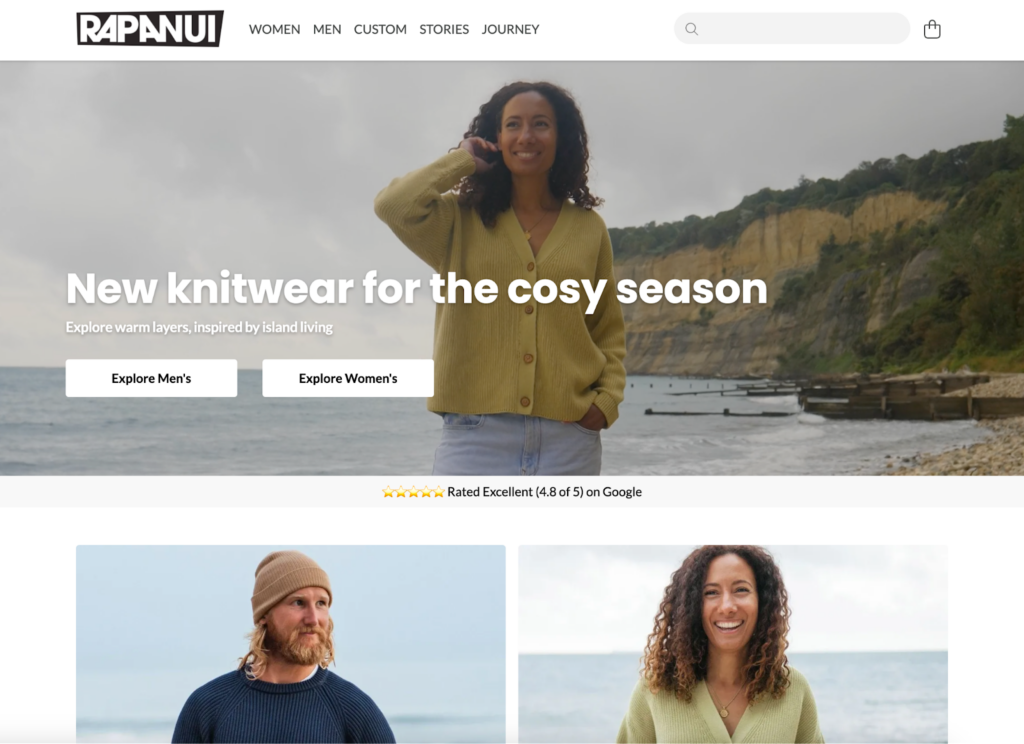
“Our commitment to a cleaner way of living and doing business has made us stronger and, like any good relationship, we take every day as it comes.”
Rapanui
🌎
How do they ensure their sustainability?
Rapanui promotes sustainability by sourcing organic and recycled materials, operating on renewable energy, and removing plastic from packaging. Their products are designed for the circular economy, where they can be returned and remade. They recover organic material from worn-out Rapanui products sent back to them and blend them with organic cotton to make new recycled cotton yarn. They print their clothes in real-time, making what people need when they need it while reducing both the waste and the cost. Their packaging is plant-based instead of plastic. Furthermore, about 95% of the water used to dye Rapanui products is recovered, cleaned, and recirculated. Furthermore, their supply chain uses renewable energy (solar and wind).
🌐
How do they ensure their ethics?
Rapanui traces most of their supply chain.
🤝
Are they part of any giving-back programs?
Rapanue shares access to the supply chain and the technology they have developed on Teemill. This open-source circular fashion platform empowers other entrepreneurs to start their own sustainable clothing brands.
🛍️
What is their product range?
- Best for: menswear, womenswear
- Product range: T-shirts, jumpsuits, playsuits, pants, shorts, hoodies, sweatshirts, socks, underwear
- Price range: $
- Size range: S–L
Swedish Stockings: Quality Stockings From Recycled Materials

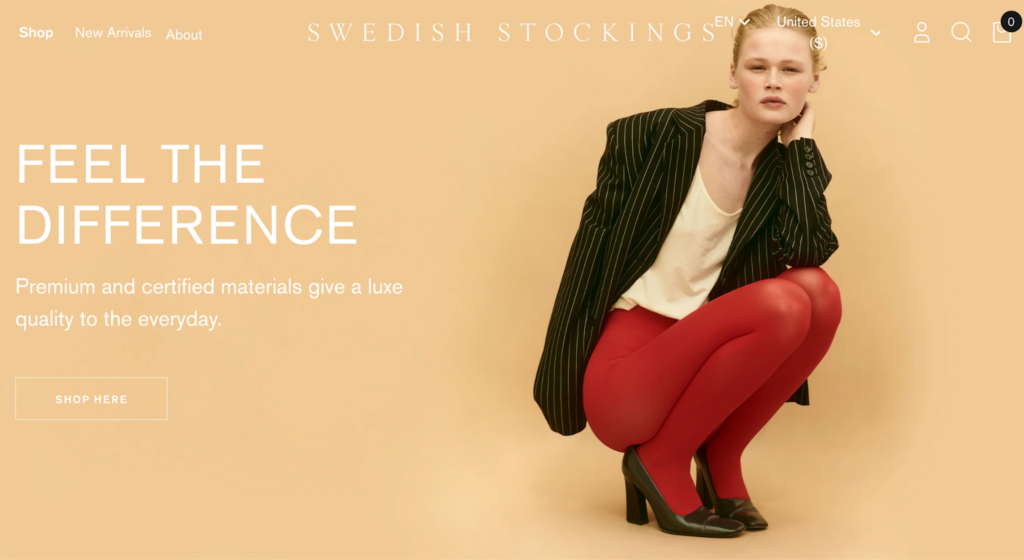
“If we can create a product that women can wear for a longer time, then we can also buy less.”
Linn Frisinger and Nadja Forsberg, Founders of Swedish Stockings
🌎
How do they ensure their sustainability?
Swedish Stockings promotes sustainability by opting for low-impact materials while minimizing waste by recycling their textile offcuts and collecting post-consumer synthetic stockings. Instead of sourcing conventional virgin fossil-based polyamide (nylon) for their tights, Swedish Stockings use high-quality recycled nylon, specifically Aquafil‘s ECONYL®, Fulgar‘s Q-NOVA® and Q-CYCLE®, and Nilit‘s SENSIL® Ecocare. They also use bio-based nylon and natural materials (GOTS-certified organic cotton, Responsible-Wool-Standard-certified organic wool, and cashmere). While they are not yet able to close their production loop by recycling old hosiery into new products themselves, Swedish Stockings still contributes to reducing textile waste by encouraging consumers to send in their used synthetic pantyhose for a 10% discount code of their products. The collected synthetic pantyhoses are turned into filler materials in tanks and tables. Additionally, Swedish Stockings uses FSC-certified packaging. Last but not least, they are transparent about the footprint of their products, disclosing the product journey along the supply chain, including the distance traveled and the cradle-to-gate impacts regarding water scarcity, global warming, eutrophication, and abiotic depletion.
🌐
How do they ensure their ethics?
Swedish Stockings has a Code of Conduct that covers the ILO’s Four Fundamental Freedoms principles. They also trace all of their supply chain. The final production stage happens in Italian factories with extremely high ethical, social, and environmental standards. They disclose all the supply partners in Italy, including any sustainability and quality certifications granted for such factories.
🤝
Are they part of any giving-back programs?
Swedish Stockings is not known to be part of any giving-back programs.
🛍️
What is their product range?
- Best for: womenswear
- Product range: stockings, tights, socks, leggings, tops, bras
- Price range: $$$
- Size range: XS–XXL
Recycled Fabrics Clothing: Breathable Natural Materials Cultivated From Organic Farms
Recycled fabrics are made with fibers reclaimed from waste. Using discarded natural or synthetic materials to produce recycled fabrics reduces pressure on extracting virgin natural resources, lowering the environmental impacts.
Here are the life-cycle stages of recycled fabrics and each stage’s sustainability assessment:
- Sourcing waste for recycled fabrics clothing: Sourcing discarded materials for making recycled fabrics is generally sustainable. It utilizes waste instead of depleting natural resources, which are, in some cases, nonrenewables. However, the carbon footprint of sourcing waste for recycled fabrics can be significant when collecting, sorting, and manufacturing hubs are far apart.
- Manufacturing of recycled fabrics clothing: The sustainability of manufacturing recycled fabrics varies depending on the type of recycling. Chemical recycling depends on chemicals to retrieve the fibers from the waste before reproducing them, creating hazardous by-products and waste. It is also relatively energy-intensive. However, chemical recycling can retain the original fibers’ properties, enabling unlimited recycling attempts and closing the textile production loop. Conversely, mechanical recycling doesn’t use toxic chemicals. However, this method of producing recycled fabrics tends to suffer from inferior quality and the limited number of times fibers can be mechanically recycled, making truly circular plastic impossible via the mechanical route.
- Transportation of recycled fabrics clothing: Transporting recycled fabrics is generally unsustainable. It can be a carbon-intensive life-cycle stage for clothing and household items made with recycled fibers due to the distances covered and emissions associated with transporting vehicles. Recycled fabrics typically travel from various locations to collection hubs, processing factories, then sorting centers, shops, and consumers’ homes before going to recycling centers or landfills.
- Usage of recycled fabrics clothing: The sustainability of using recycled fabrics varies significantly, from unsustainable (recycled synthetic fabrics) to sustainable (recycled natural fabrics). Using synthetic fabrics, virgin and recycled alike, is unsustainable mainly because washing synthetic materials during the usage phase contributes to the increasingly serious problem of microplastic presence in marine environments. Additionally, like their virgin counterparts, recycled polyester fabrics or recycled nylon fabrics are generally not breathable. They require frequent washing, thus using a great deal of water and energy. Conversely, using natural fabrics, virgin and recycled alike, is generally sustainable. And furthermore, natural materials, like recycled wool and recycled cotton, are usually breathable. They don’t need to be washed frequently—much less often than synthetic fabrics—and thus they save water and energy. Also, washing natural fabrics doesn’t cause microplastics to be released into the environment.
- End-of-life of recycled fabrics: The sustainability of recycled fabrics’ end-of-life stage depends on the recycled fibers used in manufacturing. The end-of-life of recycled fabrics made with synthetic fibers like recycled polyester or recycled nylon is unsustainable, as these materials are not biodegradable. The end-of-life of natural-based recycled fabrics like recycled wool or recycled cotton is generally sustainable. These materials are biodegradable and can be disposed of by composting, incinerating, and landfilling.
Recycled fabrics are generally considered sustainable, especially compared with their virgin counterparts (such as recycled cotton vs virgin cotton). Manufacturing recycled fabrics with discarded materials reduces waste, lessens pressure on natural resources, and demands relatively less energy. Yet, fossil-based recycled fabrics release microplastic while in use and don’t degrade during disposal.
Why Is It Important to Buy Products Made of More Sustainable Fabrics
It is important to buy products made of more sustainable fabrics because a sustainable textile industry has a lower carbon footprint, helps save natural resources, and is ultimately better for forests, animals, and humans.
Buying Sustainable Fabrics Reduces Your Carbon Footprint
The production of clothing and footwear is estimated to contribute 10% of global greenhouse gas emissions—more than all international flights and shipping combined. If the fashion industry were a country, it would be the fourth largest emitter of carbon dioxide.
One way to reduce the carbon footprint of the clothes you buy is to opt for sustainable fabrics. Sustainable fabrics, which are often made with natural or recycled fibers, have relatively low carbon footprints compared to petroleum-based fabrics. For example, recycled fabrics made in the US have a carbon footprint of 2.35 kg CO2 (per ton of spun fiber)—a quarter of polyester’s carbon footprint.
Buying Sustainable Fabrics Reduces Demand for Natural Resources and Waste Management
The textile industry uses water and land to grow cotton and other fibers. It is estimated that 79 billion cubic meters of water were used for the sector worldwide in 2015. For example, producing a single cotton T-shirt requires as much water as one person drinks for 2.5 years (2,700 liters of fresh water).
Worse yet, the textile economy is vastly more linear than circular: the largest amount of resources used in clothes ended up in landfills (instead of being recycled to remake clothes). According to a report by the Ellen MacArthur Foundation,
- Less than 3% of materials used in the textile economy in 2015 came from recycled sources.
- In other words, more than 97% of resources used in making clothes are newly extracted.
When clothing items are disposed of within a short period of time—under a year in the case of half of the fast fashion clothes—the natural systems that provide raw materials for fabrics don’t have enough time to recover and regenerate, which could lead to ecological breakdown.
Sustainable fabrics are made with less water and emissions while lasting longer:
- Because they are durable, you don’t need to buy new clothes too often.
- Thus, you help reduce the pressure to extract more resources for making new items.
Similarly, making and consuming sustainable fabrics made with recycled materials reduces the demand for virgin materials while helping tackle waste management.
Buying Sustainable Fabrics Encourages Sustainable Management of Forests
Sustainable plant-based fabrics are made with raw materials from forests and plantations that are sustainably managed, such as by complying with FSC standards.
When you buy sustainable plant-based fabrics, you discourage unsustainable forestry practices like illegal logging. By doing this, you can also help reduce deforestation, biodiversity loss, and the effects of climate change.
Buying Sustainable Fabrics Encourages Fairer Treatment of Animals
The fashion industry is rife with animal mistreatment when it comes to making animal-based fabrics like wool or silk. Every year, billions of animals suffer and die for clothing and accessories.
Buying sustainable vegan alternatives can help to reduce the pressure on raising more and more animals to meet the demand for animal-based fabrics while sacrificing their well-being and lives.
Suppose you have to buy fabrics made with, for example, wool or silk. In this case, make sure you only choose brands committed to cruelty-free products. In doing so, you help advocate better treatments for animals raised within the textile industry.
Using Sustainable Fabrics Encourages Fairer Treatment of Textile Workers
Recent statistics from UNICEF estimated as many as 170 million child laborers worldwide, many of whom were engaged in some form of work in the textile industry. They don’t get paid minimum wages and often work long hours.
When you buy sustainable fabrics from brands transparent about the working conditions at their factories, you discourage the use of child labor and help promote better working conditions for textile workers.
How Can You Generally Buy More Sustainable Fabrics
The key to sustainably buying fabrics is to check on relevant environmental and original certifications.
For natural fabrics:
- Global Organic Textile Standard (GOTS): A globally recognized certification system that ensures a certain threshold of organic content has been met. It covers manufacturing, packaging, labeling, transportation, and distribution (but not what happens in the fields where crops are grown).
- USDA Certified Biobased Product: The USDA BioPreferred® Certification is a voluntary certification offered by the United States Department of Agriculture. The certification identifies products made from plants or other renewable materials.
- Ecolabel: Ecolabel is the official European Union voluntary label recognized worldwide for certified products with a guaranteed, independently verified low environmental impact. The label requires high environmental standards throughout the entire life-cycle: from raw material extraction through production and distribution to disposal. It also encourages companies to develop innovative, durable, easy-to-repair, and recyclable products.
For plant-based semi-natural/semi-synthetic fabrics:
- Forest Stewardship Council: An FSC certification ensures that the wood (or wood-like material) comes from responsibly managed forests that provide environmental, social, and economic benefits.
There are two types of FSC Certification:- FSC Forest Management Certification, with a focus on the origin of the wood—the forest.
- FSC Chain of Custody Certification, which focuses on the path from the forest to the customer’s home.
- Program for Endorsement of Forest Certification: PEFC’s approaches to sustainable forest management are in line with protecting the forests globally and locally and making the certificate work for everyone. Getting a PEFC certification is strict enough to ensure the sustainable management of a forest is socially just, ecologically sound, and economically viable but attainable not only by big but also small forest owners.
For recycled fabrics:
- Recycled Claim Standard (RCS): The Textile Exchange RCS was originally developed as an international, voluntary standard that sets requirements for third-party certification of Recycled input and chain of custody.
- The Global Recycled Standard (GRS): The Global Recycled Standard (GRS) is an international, voluntary, full product standard that sets requirements for third-party certification of Recycled Content, chain of custody, social and environmental practices, and chemical restrictions. It can be used for any product with more than 20% recycled material.
For all types of fabrics:
- STeP by OEKO-TEX®: STeP by OEKO-TEX® is an independent certification system for brands, retailers, and manufacturers from the textile and leather industry. It communicates organizational environmental measures, including reducing carbon footprint and water usage.
- OEKO-TEX® Standard 100: OEKO-TEX® labels aim to ensure that products pose no risk to human health (i.e. containing banned chemicals).
Some certifications that are signaling brands’ efforts toward lowered environmental impacts and a circular economy are:
- B Corp Certification: The label B Corp is a certification reserved for for-profit companies. Certified holders are assessed on their social and environmental impacts.
- Cradle2Cradle certification: Cradle2Cradle provides a standardized approach to material circularity. It assesses whether products have been suitably designed and made with the circular economy in mind covering five critical categories: material health, material reuse, renewable energy and carbon management, water stewardship, and social fairness.
Final Thoughts
Recycled fabrics are generally sustainable, yet their environmental impacts vary depending on the reclaimed fiber and the recycling method. In general, manufacturing recycled fabrics with discarded materials reduces waste, lessens pressure on natural resources, and demands relatively less energy than non-recycled fabrics. However, recycled fabrics made with recycled fossil-based plastic fibers (polyester, nylon) still release microplastic while in use and clog up landfills at the end of their life as they are not biodegradable.
By purchasing new or pre-loved recycled fabrics from brands that commit to sustainability, you support their mission to create a fairer and less harmful textile industry for all lives on Earth.
Here is the list (again) of the most sustainable recycled fabrics clothing brands:
- Patagonia
- Ecoalf
- Girlfriend Collective
- MUD Jeans
- Arvin Goods
- ASKET
- Finisterre
- Vitamin A
- Rapanui
- Swedish Stockings
To make your use of these fabrics even more sustainable, follow these steps:
- Buy second-hand, recycled, or upcycled clothes made with recycled fabrics.
- While using recycled fabrics clothing, maximize the number of wears between washes and keep it as long as possible.
- At the end-of-life of your recycled fabrics clothing, upcycle the materials to extend their usage and arrange for them to be recycled or properly disposed of.
Stay impactful,

Sources
- Impactful Ninja: How Sustainable Are Recycled Cotton Fabrics? A Life-Cycle Analysis
- Impactful Ninja: How Sustainable Are Recycled Wool Fabrics? A Life-Cycle Analysis
- Impactful Ninja: How Sustainable Are Recycled Polyester Fabrics? A Life-Cycle Analysis
- Impactful Ninja: How Sustainable Are Recycled Nylon Fabrics? A Life-Cycle Analysis
- Common Objective: REPORTS & TOOLS | MADE-BY ENVIRONMENTAL BENCHMARK FOR FIBERS
- Impactful Ninja: How Sustainable Are Recycled Fabrics? A Life-Cycle Analysis
- Science Direct: Life-cycle assessment (LCA)
- Patagonia: Home
- Ecoalf: Home
- Girlfriend Collective: Home
- MUD Jeans: Home
- Arvin Goods: Home
- ASKET: Home
- Finisterre: Home
- Vitamin A: Home
- Rapanui: Home
- Swedish Stockings: Home
- Patagonia: The Climate Crisis Is Our Business
- Patagonia: The Climate Crisis Is Our Business | No More Virgin Petroleum Fibers by 2025
- Patagonia: The Climate Crisis Is Our Business | Is Each Product Worth the Environmental Cost?
- Patagonia: The Climate Crisis Is Our Business | Help Suppliers Cut Emissions
- Patagonia: Environmental Responsibility
- Impactful Ninja: How Sustainable Are Synthetic Fabrics? A Life-Cycle Analysis
- Patagonia: Recycled Polyester
- Patagonia: Recycled Nylon
- Patagonia: Recycled Spandex
- Impactful Ninja: How Sustainable Are Natural Fabrics? A Life-Cycle Analysis
- Patagonia: Recycled Sheep Wool
- Patagonia: Recycled Cashmere
- Patagonia: Recycled Down
- Patagonia: Recycled Cotton
- Patagonia: WORN WEAR
- B Corporation: Patagonia
- Bluesign®: Home
- Fair Trade: Home
- FAIR TRADE CERTIFIED: Improving Lives, Protecting the Planet.
- Patagonia: Social Responsibility
- Patagonia: Fair Trade
- Patagonia: Fair Labor Association
- Patagonia: Living Wage Program
- Patagonia: Migrant Workers Program
- Patagonia: Responsible Purchasing Practices
- Patagonia: Where We Do Business
- Patagonia: 1% for the Planet
- Forbes: Yvon Chouinard And The Patagonia Purpose Trust— What Is It And Will It Work?
- Fast Company: Patagonia uses capitalism to save the planet with the Holdfast Collective
- The New York Times: Patagonia Founder Gives Away the Company to Fight Climate Change
- Ecoalf: Materials
- Ecoalf: History
- Ecoalf: DON’T THINK IT’S A UTOPIA | DISCOVER OUR 2021 SUSTAINABILITY REPORT
- Impactful Ninja: How Sustainable Are Linen Fabrics? A Life-Cycle Analysis
- Impactful Ninja: How Sustainable Are Kapok Fabrics? A Life-Cycle Analysis
- B Corporation: Ecoalf
- Ecoalf: Sustainable Report 2021 | DON’T THINK IT’S A UTOPIA
- Ecoalf: ECOALF foundation
- Ecoalf: Upcycling the Oceans
- Ecoalf: Because There’s No Planet B
- Ecoalf: Personas
- Girlfriend Collective: About
- Girlfriend Collective: How is your recycled fabric made?
- Girlfriend Collective: Is everything eco-friendly?
- Girlfriend Collective: The Microfiber Filter
- Girlfriend Collective: Recycle. Reuse. Regirlfriend
- EcoCart: Home
- Girlfriend Collective: Are you carbon neutral
- Good On You: Brand Directory | Girlfriend Collective
- SA8000 Standards: Home
- Good On You: Brand Directory | MUDJeans
- MUDJeans: LIFE CYCLE ANALYSIS (LCA) REPORT
- MUDJeans: Creating a world without waste
- MUD Jeans: Lease A Jeans
- MUDJeans: FAQ
- MUDJeans: SUSTAINABILITY REPORT 2022
- MUDJeans: LEASE A JEANS
- MUDJeans: Happy jean makers, better jeans
- Justdiggit: Home
- Arvin Goods: RECYCLED COTTON
- Arvin Goods: HEMP BIOFIBER
- Arvin Goods: RECYCLED WOOL
- Arvin Goods: RECYCLED POLYESTER
- Arvin Goods: RECYCLED NYLON
- Textile Exchange: The RCS and GRS are designed to boost the use of recycled materials
- Arvin Goods: Take Back Bag
- Plant Dye Standard: Home
- Arvin Goods: Where it all starts.
- Arvin Goods: Our Responsibility
- Global Organic Textile Standard: Home
- Eco-X Mailers: Home
- ASKET: The Repair Program
- ASKET: The Revival Program
- ASKET: Materials | Recycled Wool
- ASKET: Materials | Recycled Cashmere
- ASKET: Materials | Recycled Synthetics
- ASKET: The Care Program
- ASKET: Full Transparency
- ASKET: TRACKING HOW WE FOLLOW OUR PRINCIPLES
- Finisterre: Fabric of Finisterre
- Finisterre: Recycled Fabrics
- Global Organic Textile Standard (GOTS): Home
- Impactful Ninja: How Sustainable Are Organic Cotton Fabrics? A Life-Cycle Analysis
- Impactful Ninja: How Sustainable Are Hemp Fabrics? A Life-Cycle Analysis
- Impactful Ninja: How Sustainable Are Bamboo Fabrics? A Life-Cycle Analysis
- Finisterre: Impact Reports
- Finisterre: Repair Workshop
- Finisterre: Finisterre x RESKINNED | REPURPOSING OLD GEAR FOR NEW ADVENTURES
- Finisterre: POSITIVE IMPACT REPORT 2022
- B Corporation: Finisterre
- Finisterre: Finisterre – A Positive Impact Business
- Finisterre: Anti-Slavery and Trafficking Policy
- Fair Working Conditions (FWC): Home
- Finisterre: Factories of Finisterre
- Open Supply Hub: Home
- Finisterre: Sea7 | The Materclasses
- Finisterre Foundation CIC: Grant Making Policy
- Finisterre: Finisterre Foundation | The Wetsuit Project
- Level Water: Home
- Finisterre: Finisterre Foundation | The Seasuit Project
- Finisterre: Finisterre Foundation | City Kids Surfing
- Vitamin A: Fabrics
- Impactful Ninja: How Sustainable Are Organic Cotton Fabrics? A Life-Cycle Analysis
- Impactful Ninja: How Sustainable Are TENCEL™ Fabrics? A Life-Cycle Analysis
- Vitamin A: Sustainability
- 1% for the Planet: Home
- Vitamin A: About
- Rapanui Clothing: Journey
- Rapanui Clothing: The future, remade.
- Good On You: Brand Directory | Rapanui Clothing
- Teemill: A Circular Economy Supplier
- Swedish Stockings: Materials
- Good On You: Brand Directory | Swedish Stockings
- Swedish Stockings: Recycling Club
- Impactful Ninja: How Sustainable Are Polyamide Fabrics? A Life-Cycle Analysis
- Aquafil: Home
- Aquafil: The ECONYL® Regeneration System
- Fulgar: Home
- Fulgar: Q-NOVA®
- Fulgar: Q-CYCLE®
- Nilit: Home
- Nilit: SENSIL® Ecocare
- Textile Exchange: Responsible Wool Standard
- Impactful Ninja: How Sustainable Are Organic Wool Fabrics? A Life-Cycle Analysis
- Impactful Ninja: How Sustainable Are Cashmere Fabrics? A Life-Cycle Analysis
- Swedish Stockings: Tights to Tables
- Swedish Stockings: Traceability
- WULCA: Water Footprint in LCA
- EPLCA: The 16 impact categories of the Environmental Footprint
- Ocean Service: What is eutrophication
- Science Direct: Abiotic Depletion Potential
- Swedish Stockings: SWEDISH STOCKINGS SUSTAINABILITY REPORT YEAR 2022
- Swedish Stockings: Factories
- European Parliament: The impact of textile production and waste on the environment (infographic)
- Science Direct: The challenge of “Depeche Mode” in the fashion industry – Does the industry have the capacity to become sustainable through circular economic principles, a scoping review
- Science Direct: Carbon Footprint of Textile and Clothing Products
- European Parliament: Environmental impact of the textile and clothing industry
- European Parliament: What if fashion were good for the planet?
- Ellen MacArthur Foundation: A New Textiles Economy: Redesigning fashion’s future
- McKinsey: Style that’s sustainable: A new fast-fashion formula
- Forest Stewardship Council: Home
- Our World in Data: Deforestation and Forest Loss
- Our World in Data: Renewable Energy
- Peta: Animals Used For Clothing
- The Guardian: Child labour in the fashion supply chain
- BioPreferred: WHAT IS THE BIOPREFERRED PROGRAM?
- European Commission: Environment | EU Ecolabel
- Forest Stewardship Council
- FSC Forest Management Certification
- FSC Chain of Custody Certification
- Program for Endorsement of Forest Certification
- Textile Exchange: The RCS and GRS are designed to boost the use of recycled materials
- OEKO-TEX: Certification according to STeP by OEKO-TEX®
- B Corp Certification: Home
- C2CCertified: Home




